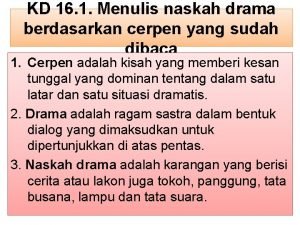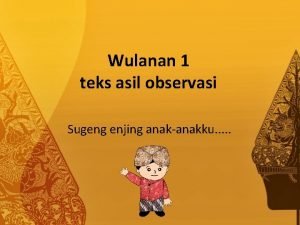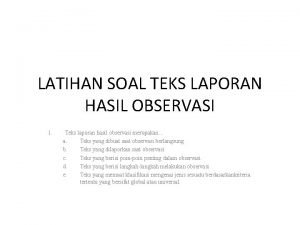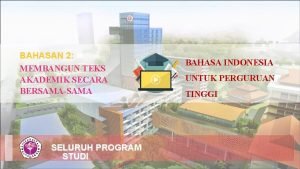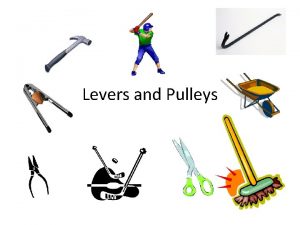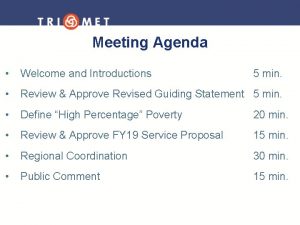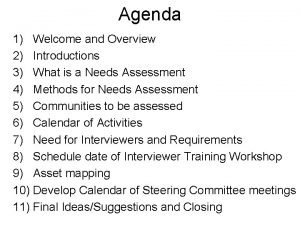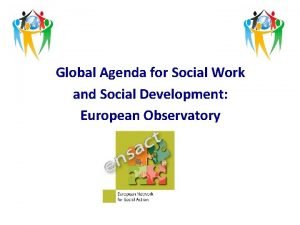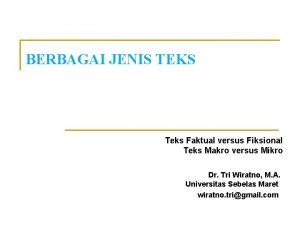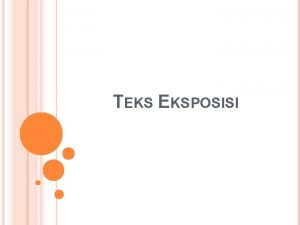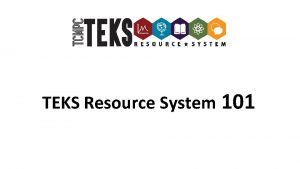Agenda 2617 TEKS 6 17 D identify and


















- Slides: 18

Agenda 2/6/17 • • • TEKS: (6. 17 D) identify and define the impact of cultural diffusion on individuals and world societies. (6. 17 E) identify examples of positive and negative effects of cultural diffusion. (6. 20 A) give examples of scientific discoveries and technological innovations, including the roles of scientists and inventors, that have transcended the boundaries of societies and have shaped the world. (6. 20 B) explain how resources, belief systems, economic factors, and political decisions have affected the use of technology. Language Objective: Students will read analyze documents about the conditions of female factory workers in Japanese silk factories. • No place for Hate video & sheet • DBQ (Document Based Question) – Female Workers in Japanese Silk Factories: Did the Costs Outweigh the Benefits? – Read Background Information/Answer Questions • HW: Finish for HW

Background Questions • 1) Japan • 2) Spinning is the process of extracting fibers from a natural product like cotton balls or silkworm cocoons and then twisting these fibers into thread. Weaving interlaces these threads together to make cloth. • 3) Because they earned money, women became more economically independent. It enabled some to leave home and help their families financially. • 4) Many women were underpaid.

Background Questions (cont. ) • Industrial Revolution – the change from hand tools to power-driven machines and factories. • Bobbin Girl – textile mill worker whose job was to tend spools of empty and filled thread. • Textile – cloth such as cotton, wool, or silk. • Spinning Jenny – English invention of the 1760 s that filled several spindles with thread at once. • Power Loom – replaced the handloom; speeded up the process of weaving thread into cloth. • Meiji Period – political period in Japan between 1868 and 1912 that featured industrial growth.

Bobbin girl

10 year old Bobbin girl

Bobbin girl

Spinning Jenny

Agenda 2/7/17 & 2/8/17 • • TEKS: (6. 17 D) identify and define the impact of cultural diffusion on individuals and world societies. (6. 17 E) identify examples of positive and negative effects of cultural diffusion. (6. 20 A) give examples of scientific discoveries and technological innovations, including the roles of scientists and inventors, that have transcended the boundaries of societies and have shaped the world. (6. 20 B) explain how resources, belief systems, economic factors, and political decisions have affected the use of technology. • Language Objective: Students will read analyze documents about the conditions of female factory workers in Japanese silk factories. • **EARLY DISMISSAL** • Review background essay ? ’s • DBQ (Document Based Question) – Female Workers in Japanese Silk Factories: Did the Costs Outweigh the Benefits? – – – Analyze Document A (Silk Factories in Nagano)- work together as class Analyze Document B (Condition of the Factory Workers)- work with partner Analyze Document C (Average Daily Wages Chart) Analyze Document E (Employment Contract) Analyze Document F (Silk Worker Survey) • HW: Finish for HW


Document A • 1) The women are pulling the silk fibers out of the cocoons of silkworms. • 2) It appears to be a clean, well-lighted place. The workers are wearing the same tidy uniform and may or may not be sitting down. Their hair is neat, which could mean the pace of work is comfortable or that they cleaned up for a company photo shoot. • 3) 61 (12, 519 female workers divided by 205 factories) • 4) The great majority of workers (92%) in the Nagano silk factories in 1901 were women. About two-thirds of the female workers (66%) were under 21. • 5) The work does not look physically demanding. The conditions appear clean and safe. With an average of 66 women in each factory, teenage girls especially would have plenty of company. • 6) The work looks tedious and boring. The workers appear regimented. They are all lifting their right arms in unison as if they are being closely watched. 18% of the workers are 14 or under. The factory is exploiting young girls.

Document B • 1) The workday began at 4: 30 am and ended at 7: 30 pm. • 2) 40 minutes per day • 3) 14 hours and 20 minutes per day • 4) 14 1/3 hours x 7 days = 100 hours and 20 minutes • 5) The girls were all in it together which could have made it tolerable. For some girls, the holidays may have been a lifesaver. • 6) The hours were brutal and there would have been well less than eight hours a night to sleep. Health would have suffered given the sleep deprivation. No leisure time and no time for reading and personal enjoyment.

Document C • 1) 13 sen • 2) 17 sen • 3) Male textile workers were paid more than female textile workers in 1900 in Japan. • 4) About 16 hours (One 14 -hour day to earn 13 sen, plus two more working hours) • 5) The pay wasn’t good, but it was almost 50% more than a female seasonal farm worker got, and also more than a female cotton worker got. • 6) The gender pay gap is disturbing. Also, working more than a 14 -hour day for one pound of sugar is unacceptable.

Document E • 1) Earnest money is like a cash advance. • 2) The family promised that the daughter would work only for the factory offering the advance and that she would work until the factory stopped operating. • 3) The parents would have to pay a sum 20 times the earnest money received. • 4) The earnest money paid to a female worker’s parents could be enough to build a house (could help the family improve their quality of life). The worker-daughter would have the satisfaction of knowing she was making a major contribution. • 5) A contract such as this could keep a worker in a factory for many years. The worker would know that if she left before her contract expired, the 20 x penalty would put a huge financial burden on her parents.

Document F • 1) 580 • 2) 100% • 3) 100% • 4) The category “Nature of Work” is close. Only 3% of the workers described the Nature of Work as being poor. The other responses were average (75%) or good (22%). • 5) The inspections • 6) It would seem from the survey that most of the girls felt good about their silk factory experience. In the survey, 90% thought the experience was positive, 10% thought it was average and none remember it as negative. Strong majorities report that the food was good and the pay between average and good. • 7) Except nerve-racking inspections, these women do appear to have forgotten the bad times. Women are the survivors.

Agenda 2/9/17 • • • TEKS: (6. 17 D) identify and define the impact of cultural diffusion on individuals and world societies. (6. 17 E) identify examples of positive and negative effects of cultural diffusion. (6. 20 A) give examples of scientific discoveries and technological innovations, including the roles of scientists and inventors, that have transcended the boundaries of societies and have shaped the world. (6. 20 B) explain how resources, belief systems, economic factors, and political decisions have affected the use of technology. Language Objective: Students will complete their outline about the conditions of female factory workers in Japanese silk factories. • DBQ (Document Based Question) – Female Workers in Japanese Silk Factories: Did the Costs Outweigh the Benefits? • START OUTLINE- write with partner ( INTRODUCTION, BODY PARAGRAPH) • Write final draft • HW: FINAL ESSAY DUE AT BEGINNING OF CLASS MONDAY 2/13

Agenda 2/10/17 • • • TEKS: (6. 17 D) identify and define the impact of cultural diffusion on individuals and world societies. (6. 17 E) identify examples of positive and negative effects of cultural diffusion. (6. 20 A) give examples of scientific discoveries and technological innovations, including the roles of scientists and inventors, that have transcended the boundaries of societies and have shaped the world. (6. 20 B) explain how resources, belief systems, economic factors, and political decisions have affected the use of technology. Language Objective: Students will begin writing their final drafts about the conditions of female factory workers in Japanese silk factories. • DBQ (Document Based Question) – Female Workers in Japanese Silk Factories: Did the Costs Outweigh the Benefits? – PEER GRADE- staple rubric to paper – Review rubric expectations – Peer grade 3 essays • HW: FINAL ESSAY DUE AT BEGINNING OF CLASS TOMORROW

Document D • 1) Western countries generally refer to countries in Europe like England, France, and Germany as well as the United States. • 2) Working hours are fewer in the West because women are more likely to continue factory work after marriage. These older female Western factory workers could not endure the long hours for a lifetime. • 3) The chart does not support the Government Report. The chart shows that only 6% of the female mill workers who left did so for reasons of marriage. Four times as many, 24%, did it because of illness. • 4) If the Government Report is accurate that for most girls the work was temporary, that was a benefit. For some girls, the long hours might have been a bearable challenge, as long as it wasn’t for more than a year or two. • 5) The 1909 chart challenges the Government Report’s claim that the girls could physically handle the long hours, and that they left for reasons of marriage. The fact that four times as many girls left for personal health reasons as they did for marriage suggests that illness was a significant cost. The government appears to be misrepresenting the truth.

Document G • 1) An unnamed Japanese silk factory worker. • 2) 12 years old • 3) 4 pm to 4 am. In other words, a 12 -hour night shift. • 4) She writes “We don’t cross the Nomugi Pass for nothing, We do it for ourselves and our parents. ” That is, for unspoken reasons, she’s doing it to fulfill some personal need or goal. • 5) She is worried her parents might be thinking more about collecting her pay than about seeing her. • 6) The negatives are several: the factory is cruel; the reeling of silk is painful; she misses her parents; her parents “sold her to the factory. ” • 7) There are several positives: (1) She is of economic benefit to her family who placed her under contract; (2) she is doing it for herself, although for unspoken reasons; (3)the year is coming to an end, which suggests a short contract; (4)she has the possibility of marriage in the future.
 Agenda sistemica y agenda institucional
Agenda sistemica y agenda institucional Buatlah naskah drama berdasarkan kutipan cerpen berikut
Buatlah naskah drama berdasarkan kutipan cerpen berikut Isi ing lapuran asil observasi yaiku
Isi ing lapuran asil observasi yaiku Tujuan utama merevisi teks hasil observasi adalah.......
Tujuan utama merevisi teks hasil observasi adalah....... Teks tersebut merupakan jenis teks
Teks tersebut merupakan jenis teks Fle levers
Fle levers Meet and greet agenda
Meet and greet agenda Meeting agenda welcome and introductions
Meeting agenda welcome and introductions Agenda welcome and introductions
Agenda welcome and introductions Agenda welcome and introductions
Agenda welcome and introductions Agenda welcome and introductions
Agenda welcome and introductions Agenda welcome and introductions
Agenda welcome and introductions Agenda welcome and introductions
Agenda welcome and introductions Global agenda for social work and social development
Global agenda for social work and social development Agenda 21 and 30
Agenda 21 and 30 Meeting agenda welcome and introductions
Meeting agenda welcome and introductions Agenda welcome and introductions
Agenda welcome and introductions Agenda web definite and indefinite article
Agenda web definite and indefinite article Agenda welcome and introductions
Agenda welcome and introductions

